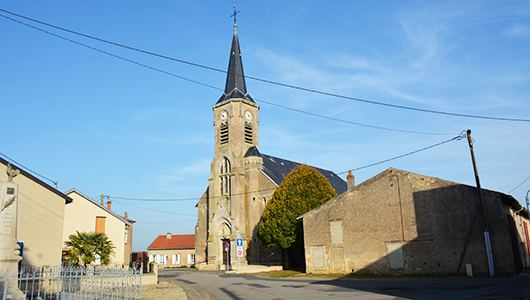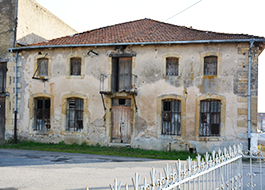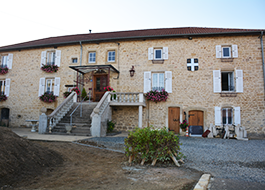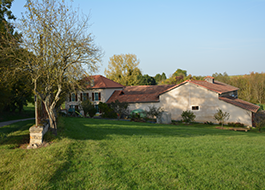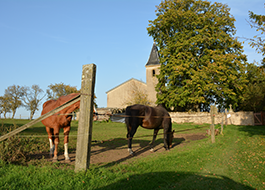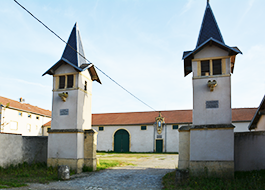Chambley-Bussières
Durée visite : 90 minutes
Moyen : Pédestre
On trouve des vestiges de constructions gallo-romaines. Le village appartenait à l’ancienne province des Trois-Évêchés. A partir de 1648, celle-ci regroupait les territoires de Metz, Toul et Verdun cédés à la France. Cette commune fut un village-frontière avec l’Allemagne entre 1871 et 1918. De 1953 à 1967, Chambley abrita une base de l’ OTAN. Michael Collins a été commandant en second de la base de Chambley. Il s’est marié dans la commune en 1957, puis une deuxième fois en 1967. En juillet 1969, lors de la mission Appolo 11, qui vit le premier homme marcher sur la Lune, Collins vola en tant que pilote du module de commande. Tandis que ses coéquipiers, Neil Armstrong et Buzz Aldrin, atterrirent et marchèrent sur la surface lunaire, Collins resta en orbite lunaire dans le module. À l’époque, il fut décrit comme la personne la plus solitaire sur et en dehors de la planète. Quand il volait au-dessus de la face cachée de la Lune, il était à au moins 3 200 kilomètres de ses collègues, et à plus de 350 000 kilomètres du reste des humains. Collins n’avait aucune possibilité de communiquer par radio avec la Terre. Dans son journal de bord, il écrira à ce sujet qu’il représentait la vie à lui tout seul. Il ajouta que ce sentiment lui plaisait . Après le départ de l’USAF, la base est rétrocédée à l’Armée de l’Air. Elle accueille désormais le club ULM Sports et loisirs, une école de conduite et de pilotage, le Mondial Air Ballons.
There are remains of Gallo-Roman constructions. The village belonged to the former province of Trois-Évêchés. From 1648, this brought together the territories of Metz, Toul and Verdun ceded to France. This town was a border village with Germany between 1871 and 1918. From 1953 to 1967, Chambley housed a NATO base. Michael Collins was the second in command of Base Chambley. He married in the township in 1957, then a second time in 1967. In July 1969, during the Appolo 11 mission, which saw the first man walk on the moon, Collins flew as a command module pilot. While his teammates, Neil Armstrong and Buzz Aldrin, landed and walked on the lunar surface, Collins remained in lunar orbit in the module. At the time, he was described as the loneliest person on and off the planet. When he flew over the far side of the moon, he was at least 3,200 kilometers from his colleagues, and over 350,000 kilometers from the rest of humans. Collins had no possibility of radio communication with Earth. In his logbook, he will write about it that he represented life all to himself. He added that he liked the feeling. After the departure of the USAF, the base was handed over to the Air Force. It now hosts the ULM Sports and Recreation club, a driving and flying school, the Mondial Air Ballons.
Es gibt Überreste galloromanischer Konstruktionen. Das Dorf gehörte zur ehemaligen Provinz Trois-Évêchés. Ab 1648 brachte dies die an Frankreich abgetretenen Gebiete Metz, Toul und Verdun zusammen. Diese Stadt war zwischen 1871 und 1918 ein Grenzdorf zu Deutschland. Von 1953 bis 1967 beherbergte Chambley eine NATO-Basis. Michael Collins war der zweite Befehlshaber der Chambley-Basis. Er heiratete 1957 in der Gemeinde, dann 1967 ein zweites Mal. Im Juli 1969 flog Collins während der Appolo 11-Mission, bei der der erste Mann auf dem Mond lief, als Kommandomodulpilot. Während seine Teamkollegen Neil Armstrong und Buzz Aldrin auf der Mondoberfläche landeten und gingen, blieb Collins im Modul in der Mondumlaufbahn. Zu dieser Zeit wurde er als der einsamste Mensch auf und neben dem Planeten beschrieben. Als er über die andere Seite des Mondes flog, war er mindestens 3.200 Kilometer von seinen Kollegen und über 350.000 Kilometer vom Rest der Menschen entfernt. Collins hatte keine Möglichkeit der Funkverbindung mit der Erde. In seinem Logbuch wird er darüber schreiben, dass er das Leben ganz für sich selbst repräsentiert hat. Er fügte hinzu, dass er das Gefühl mochte. Nach dem Abzug der USAF wurde die Basis an die Luftwaffe übergeben. Es beherbergt jetzt den ULM Sport- und Freizeitclub, eine Fahr- und Flugschule, die Mondial Air Ballons.

De sable à la croix cantonnée de quatre fleurs de lys d’or.
Ce sont les armes de la famille de Chambley de l’ancienne chevalerie lorraine, déjà éteinte au XVIIe siècle. Elle a ajouté à son nom celui de Bussières, son hameau, le 15 septembre 1942.
Of sand to the cross quartered by four fleur-de-lis gold.
These are the arms of the Chambley family of the old Lorraine chivalry, already extinct in the 17th century. She added to her name that of Bussières, her hamlet, on September 15, 1942.
Aus Sand bis zum Kreuz, geviertelt von vier Lilie Gold.
Dies sind die Wappen der Familie Chambley der alten lothringischen Ritterlichkeit, die bereits im 17. Jahrhundert ausgestorben ist. Sie fügte ihrem Namen am 15. September 1942 den Namen Bussières, ihren Weiler, hinzu.

Les habitants et les habitantes de Chambley-Bussières s’appellent les Chambleysiens et les Chambleysiennes.
The inhabitants of Chambley-Bussières are called Chambleysiens and Chambleysiennes.
Die Einwohner von Chambley-Bussières heißen Chambleysiens und Chambleysiennes.
Les points de visites
.
Hélas, ce bâtiment ayant été rasé en 2022, vous devrez désormais vous contenter de sa photo. Avant la libéralisation de 1763, la loi fondamentale sur les marchands de grains est la déclaration royale du 31 août 1699. C’est une véritable charte du commerce des grains. Elle compile des textes multiples, locaux ou gouvernementaux. La police des grains est une série d’interdictions rigoureuses, à applications discontinues et occasionnelles, entre lesquelles s’étendent de vastes périodes de tolérance et une foule de fraudes. La loi la plus commune est celle du marché mandataire. C’est l’obligation pour tous d’acheter et de vendre au marché, sauf pour les ruraux en ce qui concerne leur consommation quotidienne . Les entraves à ce commerce sont nombreuses : un régime réglementaire incertain, la difficulté, la cherté et l’insécurité des transports, la diversité des poids et mesures, les droits de circulation et de marché. Mais les déséquilibres entre les régions multiplient les opportunités de spéculation.
Alas, this building having been razed in 2022, you will now have to be satisfied with its photo. Before the liberalization of 1763, the fundamental law on grain merchants was the royal declaration of August 31, 1699. It was a true grain trade charter. She compiles multiple texts, local or government. The grain policing is a series of rigorous prohibitions, applied intermittently and occasionally, between which extend broad periods of tolerance and a host of frauds. The most common law is that of the agent market. It is the obligation for everyone to buy and sell in the market, except for rural people for their daily consumption. The obstacles to this trade are numerous: an uncertain regulatory regime, the difficulty, high cost and insecurity of transport, the diversity of weights and measures, traffic and market rights. But the imbalances between the regions increase the opportunities for speculation.
Leider wurde dieses Gebäude im Jahr 2022 abgerissen, Sie müssen sich jetzt mit seinem Foto zufrieden geben. Vor der Liberalisierung von 1763 war das Grundgesetz über Getreidehändler die königliche Erklärung vom 31. August 1699. Es war eine echte Getreidehandelscharta. Sie stellt mehrere lokale oder staatliche Texte zusammen. Die Getreidepolizei ist eine Reihe strenger Verbote, die zeitweise und gelegentlich angewendet werden und zwischen denen sich breite Toleranzperioden und eine Vielzahl von Betrügereien erstrecken. Das gängigste Gesetz ist das des Agentenmarktes. Es ist die Verpflichtung für alle, auf dem Markt zu kaufen und zu verkaufen, mit Ausnahme der Landbevölkerung für ihren täglichen Verbrauch. Die Hindernisse für diesen Handel sind zahlreich: ein unsicheres Regulierungssystem, die Schwierigkeit, die hohen Kosten und die Unsicherheit des Verkehrs, die Vielfalt der Gewichte und Maße, die Verkehrs- und Marktrechte. Die Ungleichgewichte zwischen den Regionen erhöhen jedoch die Spekulationsmöglichkeiten.
.
.
Ce château fort fut la propriété des Chambley au Moyen Âge. Il est passé par mariage, au milieu du XVe siècle, à la famille de Haraucourt. Puis par donation, en 1727, il échut à la famille du Châtelet qui le conserva jusqu’à la Révolution. Le château fut assiégé en 1636, au cours de la guerre de Trente Ans, par Abraham de Fabert d’Esternay, futur maréchal de France. Voici un extrait du journal de Jean Bauchez (mort vers 1660) qui relate la prise du château de Chambley. Il en fut le témoin oculaire « Entrant donc au Château, ils mettent à mort ceux qu’ils rencontraient, tout étant mis à discrétion des soldats. S’ils voulaient prendre prisonnier ou tuer, cela leur était permis. Pour les femmes et les filles les plus belles, elles furent menées au jeu de Vénus, les autres furent accouplées et menées au château de Charey pour leur faire payer rançon. Le château de Chambley fut détruit, puis reconstruit. Après la Révolution de 1789, il n’en restait plus grand-chose. Plus de remparts, plus de tours. Les pierres ont servi à l’édification d’autres demeures par les résidents locaux. Les héritiers du château ont pu reprendre possession de leur bien en 1812. Ils le rebâtir pour lui donner l’aspect que nous voyons aujourd’hui. Pendant la 1re Guerre mondiale, le château servit de base arrière aux lignes allemandes, qui en firent un hôpital. Le bâtiment était occupé par les médecins militaires. Ils y firent édifier un bâtiment annexe dans le jardin arrière, servant à abriter et à soigner les blessés.
This fortified castle was the property of Chambley in the Middle Ages. He passed by marriage, in the middle of the 15th century, to the Haraucourt family. Then by donation, in 1727, it fell to the Châtelet family who kept it until the Revolution. The castle was besieged in 1636, during the Thirty Years’ War, by Abraham de Fabert d’Esternay, future Marshal of France. Here is an extract from the diary of Jean Bauchez (died around 1660) which relates the capture of the castle of Chambley. He was the eyewitness. « So entering the Castle, they put to death those they met, everything being put at the discretion of the soldiers. If they wanted to take prisoner or kill, they were allowed to do so. For the most beautiful women and girls, they were taken to the game of Venus, the others were mated and taken to Charey Castle to make them pay ransom. Chambley castle was destroyed and then rebuilt. After the Revolution of 1789, there wasn’t much left. No more ramparts, no more towers. The stones were used to build other homes by local residents. The heirs of the castle were able to take back possession of their property in 1812. They are rebuilding it to give it the appearance we see today. During World War I, the castle served as a rear base for the German lines, which turned it into a hospital. The building was occupied by military doctors. They had an annex building erected there in the rear garden, used to shelter and treat the wounded.
Diese befestigte Burg war im Mittelalter Eigentum von Chambley. Er heiratete Mitte des 15. Jahrhunderts die Familie Haraucourt. Dann fiel es 1727 durch eine Spende an die Familie Châtelet, die es bis zur Revolution aufbewahrte. Die Burg wurde 1636 während des Dreißigjährigen Krieges von Abraham de Fabert d’Esternay, dem zukünftigen Marschall von Frankreich, belagert. Hier ist ein Auszug aus dem Tagebuch von Jean Bauchez (gestorben um 1660), der die Eroberung des Schlosses von Chambley erzählt. Er war der Augenzeuge. « Als sie das Schloss betraten, töteten sie diejenigen, denen sie begegneten, und alles lag im Ermessen der Soldaten. Wenn sie gefangen genommen oder getötet werden wollten, durften sie dies tun. Für die schönsten Frauen und Mädchen wurden sie zum Spiel der Venus gebracht, die anderen wurden gepaart und nach Charey Castle gebracht, um sie Lösegeld zahlen zu lassen. Das Schloss von Chambley wurde zerstört und dann wieder aufgebaut. Nach der Revolution von 1789 war nicht mehr viel übrig. Keine Wälle mehr, keine Türme mehr. Die Steine wurden von Anwohnern verwendet, um andere Häuser zu bauen. Die Erben des Schlosses konnten 1812 ihr Eigentum zurückerobern. Sie bauen es wieder auf, um es so aussehen zu lassen, wie wir es heute sehen. Während des Ersten Weltkriegs diente die Burg als hinterer Stützpunkt für die deutschen Linien, die sie in ein Krankenhaus verwandelten. Das Gebäude wurde von Militärärzten besetzt. Sie ließen dort im hinteren Garten ein Nebengebäude errichten, in dem die Verwundeten untergebracht und behandelt wurden.
.
Le mot moulin vient du latin molinum dérivé de mola, la meule. Il désigne l’appareil à moudre le grain des céréales et l’établissement qui utilise ces machines. Des moulins à farine sont mentionnés sur les rivières de la région dès le 11e siècle. Propriétés de seigneurs ou de communautés religieuses, ils sont répartis le long des cours d’eau sur l’ensemble du territoire. Nombre d’entre eux sont associés à un moulin à vent. Ce dernier pallie le manque d’eau en période d’étiage. Leur équipement se réduit jusqu’à la fin du XVIIIe siècle à un système mécanique simple. Il est composé d’une ou plusieurs roues hydrauliques. Elles entraînent chacune une paire de meules. Ces dernières sont faites de pierre tendre, en général extraite localement. La pierre est piquée à l’aide d’un marteau. Cela lui donne l’aspérité nécessaire au broyage. Le piquage a lieu tous les quarante jours en moyenne. Ce qui fait qu’elles ne durent pas plus de deux ans. Seule la meule supérieure tourne pour écraser le grain sur la meule inférieure. La mouture grossière obtenue est dite à la grosse. La farine est en effet mêlée au son. Avant leur mouture, les grains sont lavés à l’eau puis séchés au soleil. En 1818, la production moyenne d’un moulin est d’environ 350 kg de farine par jour. Le pain est jusqu’au milieu du 20e siècle, l’aliment de référence. En 1889, on estime à 530 g la consommation de pain, par jour et par personne.
The word mill comes from the Latin molinum derived from mola, the millstone. It designates the machine for grinding the grain of cereals and the establishment that uses these machines. Flour mills are mentioned on the rivers of the region as early as the 11th century. Owned by lords or religious communities, they are distributed along the waterways throughout the territory. Many of them are associated with a windmill. The latter compensates for the lack of water during low water periods. Their equipment was reduced until the end of the 18th century to a simple mechanical system. It is made up of one or more water wheels. They each drive a pair of grindstones. These are made of soft stone, generally mined locally. The stone is pitted with a hammer. This gives it the roughness necessary for grinding. The stitching takes place every forty days on average. So they don’t last more than two years. Only the upper wheel rotates to crush grain on the lower wheel. The coarse grinding obtained is said to be coarse. The flour is indeed mixed with the bran. Before milling, the beans are washed with water and then dried in the sun. In 1818, the average production of a mill was about 350 kg of flour per day. Bread was the benchmark food until the middle of the 20th century. In 1889, the consumption of bread was estimated at 530 g per day and per person.
Das Wort Mühle stammt aus dem lateinischen Molinum, das von Mola, dem Mühlstein, abgeleitet ist. Es bezeichnet die Maschine zum Mahlen des Getreidekorns und die Einrichtung, in der diese Maschinen eingesetzt werden. Bereits im 11. Jahrhundert werden an den Flüssen der Region Mühlen erwähnt. Sie gehören Lords oder Religionsgemeinschaften und sind entlang der Wasserstraßen im gesamten Gebiet verteilt. Viele von ihnen sind mit einer Windmühle verbunden. Letzteres gleicht den Wassermangel in Niedrigwasserperioden aus. Ihre Ausrüstung wurde bis zum Ende des 18. Jahrhunderts auf ein einfaches mechanisches System reduziert. Es besteht aus einem oder mehreren Wasserrädern. Sie fahren jeweils ein Paar Schleifsteine. Letztere bestehen aus weichem Stein, der normalerweise vor Ort abgebaut wird. Der Stein wird mit einem Hammer entkernt. Dies gibt ihm die zum Schleifen notwendige Rauheit. Das Nähen erfolgt durchschnittlich alle vierzig Tage. Sie halten also nicht länger als zwei Jahre. Nur das obere Rad dreht sich, um das Korn am unteren Rad zu zerkleinern. Das erhaltene Grobmahlen soll grob sein. Das Mehl wird tatsächlich mit der Kleie gemischt. Vor dem Mahlen werden die Bohnen mit Wasser gewaschen und anschließend in der Sonne getrocknet. Im Jahr 1818 betrug die durchschnittliche Produktion einer Mühle etwa 350 kg Mehl pro Tag. Brot war bis Mitte des 20. Jahrhunderts der Maßstab. 1889 wurde der Brotkonsum auf 530 g pro Tag und Person geschätzt.
.
Buscarias-villa jadis, Bussières aujourd’hui. Ce hameau, d’une trentaine d’âmes, est composé de maisons et fermes anciennes. Quelques nouvelles habitations ont été bâties. Situé à l’écart, il fait partie de la commune de Chambley. Des haras nationaux y sont établis depuis 1977.
Saint Gorgon est patron du hameau, la chapelle est dédiée à la nativité de la Vierge. Le tilleul du XVIe siècle fait partie des ARBRES. L’acronyme signifie : Arbres Remarquables Bilan Recherche Etude Sauvegarde L’église paroissiale de la-Nativité-de la-Vierge a été construite au XVe siècle. Elle a été agrandie au XVIIIe. Sa tour est du XVIIIe siècle, elle est restaurée au XIXe. La sacristie est réalisée au XIXe siècle.
A proximité se trouvent des plants d’aristoloche. Ce nom vient du grec. Il signifie excellent accouchement. Elle est depuis longtemps connue pour ses vertus médicinales.
Buscarias-villa once, Bussières today. This hamlet, of around thirty souls, is made up of old houses and farms. Some new homes were built. Located out of the way, it is part of the commune of Chambley. National stud farms have been established there since 1977.
Saint Gorgon is patron of the hamlet, the chapel is dedicated to the nativity of the Virgin. The 16th century lime tree is part of the TREES. The acronym stands for: Remarkable Trees Assessment Research Study Safeguarding The parish church of the Nativity of the Virgin was built in the 15th century. It was enlarged in the 18th century. Its tower is from the 18th century, it was restored in the 19th century. The sacristy was built in the 19th century.
Nearby are aristolochia plants. This name comes from the Greek. It means excellent childbirth. It has long been known for its medicinal properties.
Buscarias-Villa einmal, Bussières heute. Dieser Weiler mit etwa dreißig Seelen besteht aus alten Häusern und Bauernhöfen. Einige neue Häuser wurden gebaut. Es liegt abseits und ist Teil der Gemeinde Chambley. Dort werden seit 1977 nationale Gestüte eingerichtet.
Saint Gorgon ist Patron des Weilers, die Kapelle ist der Geburt der Jungfrau gewidmet. Die Linde aus dem 16. Jahrhundert ist Teil der BÄUME. Das Akronym steht für: Bemerkenswerte Bäume Bewertung Forschungsstudie Schutz Die Pfarrkirche der Geburt der Jungfrau wurde im 15. Jahrhundert erbaut. Es wurde im 18. Jahrhundert erweitert. Sein Turm stammt aus dem 18. Jahrhundert und wurde im 19. Jahrhundert restauriert. Die Sakristei wurde im 19. Jahrhundert erbaut.
In der Nähe befinden sich Aristolochia-Pflanzen. Dieser Name kommt aus dem Griechischen. Es bedeutet eine hervorragende Geburt. Es ist seit langem für seine medizinischen Eigenschaften bekannt.
.
A la sortie de Bussières, on découvre une très belle ferme. Elle est appelée Notre-Dame du Chatelet. Elle se présente sous la forme de bâtiments autour d’une cour fermée. L’accès est encadré par deux pigeonniers. Ils ont un aspect de type clocher-tour. Dans l’axe de l’entrée, on peut apercevoir sur la façade une petite niche. Elle abrite une statue de la Vierge à l’Enfant.. Elle est accompagnée d’une inscription en latin : Ave Stella Matutina. Elle signifie Salut Etoile du Matin. De belle portes charretières sont visibles de part et d’autre de la statue.
At the end of Bussières, we discover a very beautiful farm. It is called Notre-Dame du Chatelet. It takes the form of buildings around an enclosed courtyard. Access is framed by two dovecotes. They have a bell tower-like appearance. In the axis of the entrance, one can see on the facade a small niche. It houses a statue of the Virgin and Child. It is accompanied by an inscription in Latin: Ave Stella Matutina. It means Hello Morning Star. Beautiful carriage doors are visible on both sides of the statue.
Am Ende von Bussières entdecken wir einen sehr schönen Bauernhof. Es heißt Notre-Dame du Chatelet. Es besteht aus Gebäuden rund um einen geschlossenen Innenhof. Der Zugang wird von zwei Taubenschlägen eingerahmt. Sie haben ein glockenturmartiges Aussehen. In der Achse des Eingangs sieht man an der Fassade eine kleine Nische. Es beherbergt eine Statue der Jungfrau und des Kindes und wird von einer lateinischen Inschrift begleitet: Ave Stella Matutina. Es bedeutet Hallo Morgenstern. Auf beiden Seiten der Statue sind schöne Wagentüren sichtbar.

